Extend
AG Architect Live Effect
AG Architect Live Effect
AG Architect Panel
Extend Path Tool
AG Utilities Live Effects
Illustrator Location:
Illustrator Main Menu > Window > Astute Graphics > AG Architect
AG Architect is an Astute Graphics live effect that adds extension lines to path segments, which can be used to give live text or paths an architectural blueprint feel, or for other special effects. A wide variety of parameters can be specified through a panel interface, such as whether the lines appear on curved or straight segments; the lines’ length, style, and position; and whether or not to randomize the results. AG Architect is part of the Stylism plugin.
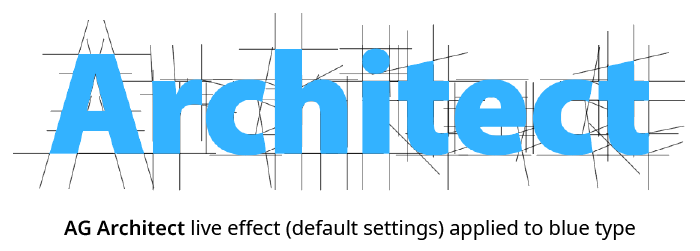
AG Architect Default Example
As with most live effects, AG Architect appears in the main menu, under Effect > Stylism > AG Architect. It can also be applied directly from the Appearance panel using the “Add New Effect” button at the bottom of the panel. However, the easiest way to apply the live effect is using the Apply button on the AG Architect panel.
Illustrator Location:
Illustrator Main Menu > Window > Astute Graphics > AG Architect
The AG Architect live effect does not have a modal parameters dialog, but is instead edited using a panel, which can be shown and hidden using the menu item found in the main menu at Window > Astute Graphics > AG Architect. When at least one selected object has the AG Architect live effect applied, the panel controls will update to reflect the parameters of those effects, which can then be edited. A value field which is blank or (for checkboxes) with a dash indicates that the parameter has different values in the selection. These can be unified (made the same) by entering a new value.

AG Architect Panel
1. Flyout menu
See AG Architect Panel: Flyout Menu.
2. Panel banner
The help button on the right opens the help documentation in the Astute Manager. If this does not automatically appear, please ensure your Astute Manager is running first.
3. Segments
Extension lines will be added to path segments which are curved and/or straight, when the corresponding option is enabled.

AG Architect Curved Straight Example
4. Only If Angle Is
When enabled, extension lines are only added if their angle matches the specified value (within the specified tolerance). Angles are measured using the normal Illustrator convention.

AG Architect Only if Angle is Example
5. Include 180-Degree Differences
When using the Only if Angle is setting, specifies that directions 180° from the specified angle should be considered the same.
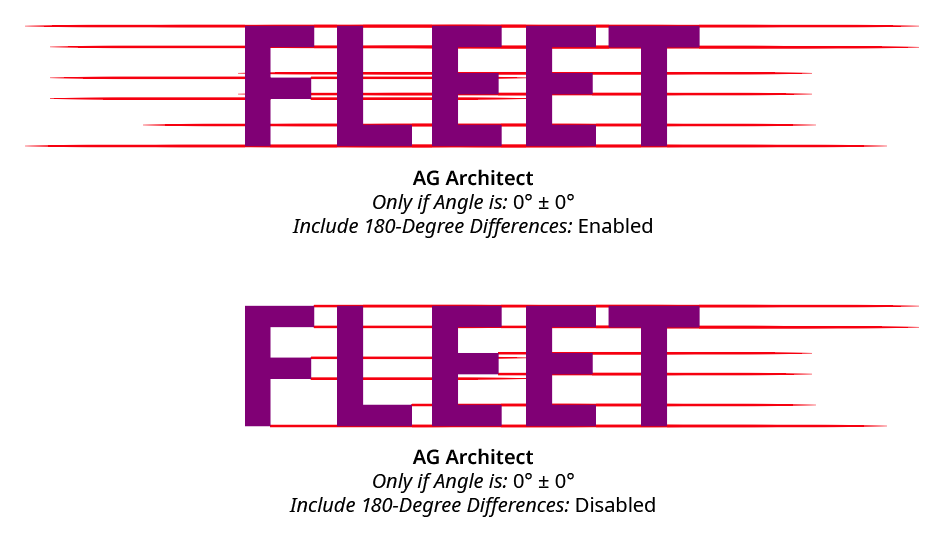
AG Architect 180 Degree Difference Example
6. Only If Length is
When enabled, extension lines are only added to path segments that are longer than the specified length.
7. Joins
Extension lines will be applied at the ends of path segments which end in smooth or corner anchor points, when the corresponding option is enabled.
8. Open Path Endpoints
Extension lines will be added at the ends of open paths.
9. Holes in Compound Paths
Extension lines will be applied to path segments which comprise subpaths which form holes in compound paths.
10. Positioning
The stacking position of the extension lines relative to the original source art, from among Above Original, Replace Original, or Below Original.

AG Architect Positioning Example
11. Length
The base length of the extension lines (before any randomization). When the dropdown menu is set to Absolute, the length is specified as an absolute value (for example, 15 pt). When the dropdown men is set to Relative, the length is specified as a percentage of the diagonal length of the source path’s bounding box.
12. Stroke
The stroke style of the extension lines, as specified using the dropdown menu. When set to Use Original, the stroke’s style is taken from the original source path (except dashes are not preserved). Otherwise, the color, weight, or both is set to the specified values.
13. Color
Available when the stroke is set to Specify Color or Specify Both; specifies the color of the extension lines. Clicking the color chip brings up a standard color picker dialog.
14. Weight
Available when the stroke is set to Specify Weight or Specify Both; specifies the stroke weight of the extension lines.
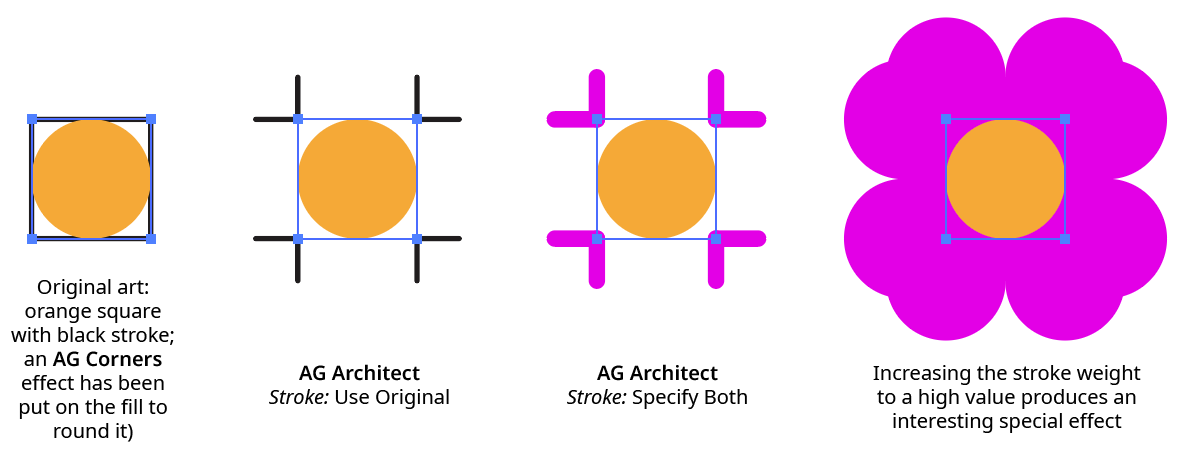
AG Architect Stroke Example
15. Extend As
Specifies the extension’s geometry, either Straight (all extension lines are straight) or Smooth Curve (extensions from curved path segments will also be curved, following the natural extension of the bezier curve’s shape).

AG Architect Extend As Example
16. End Style
Specifies the style for the terminus of the extension lines.
Normal extension line end without any special treatment; the end cap type is either taken from the stroke on the original path (if the Stroke setting is set to Use Original or Specify Color), else is set to Butt Cap type.
Tapered extension line thin to a sharp point. The length of the tapered portion of the line can be specified either as an absolute distance or as a percentage of the total line length. When AG Architect effects with Tapered extension lines are expanded, the lines are converted into closed path shapes.
Dashed extension line end in one or more dashes, which shorten towards the end of the line. The number of dashes can be changed (from 1 to 9), and the length of the dashed portion of the line can be specified either as an absolute distance or as a percentage of the total line length.

AG Architect End Styles
17. Randomize
When enabled, several of the live effect’s parameters can be randomly varied: the length of the extensions, the dash count (if Dashed end type is used), and the probability that an extension line will be created at all.
18. Seed
Each random seed number leads to a different sequence of random values. Clicking the button picks a new seed, thereby changing the look of the artwork. To view or specify the seed number directly, Option/Alt-click the button. This lets you recreate a previously-generated look.
19. Length Variation
When randomization is enabled, specifies the maximum amount of variation in the final extension line length. For example, if the length is set to 20 pt, then a variation value of 25% would produce lengths that vary by as much as 20 pt × 25% = 5 pt, that is, between 15 pt and 20 pt; a variation value of 90% would produce lengths between 2 pt and 20 pt.
20. Dash Count Variation
When randomization is enabled, specifies the random variation in the dash count (when using the Dashed end type). For example, if the count is set to 8, then a variation value of 25% would produce count values that vary by as much as 8 × 25% = 2, that is, either 7 or 8; a variation value of 100% would produce count values between 1 and 8.
21. Retention Probability
When randomization is enabled, specifies the probability that an extension line will be created at each spot where one is eligible.
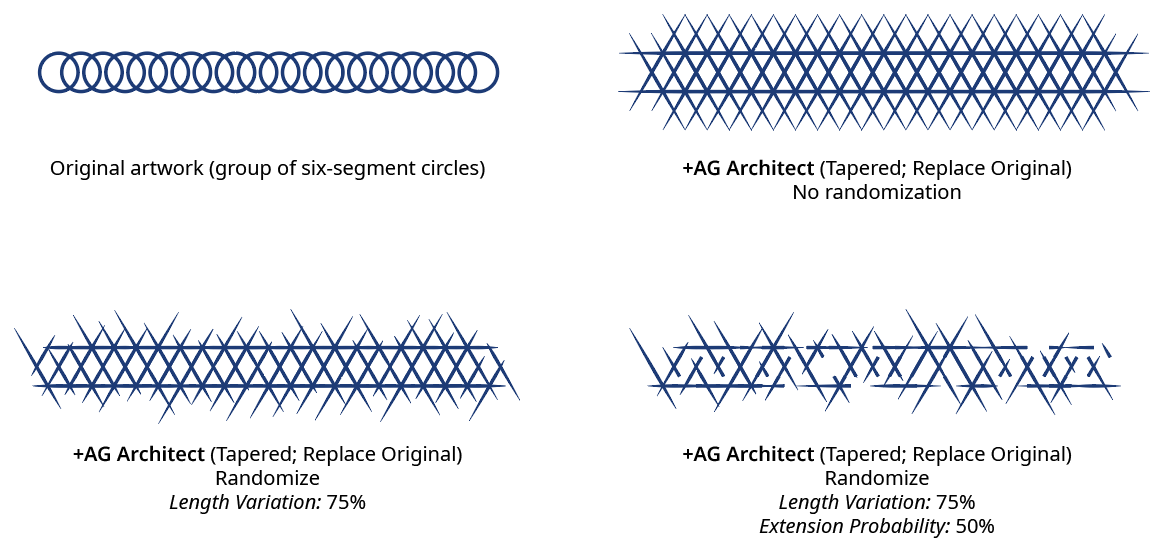
AG Architect Randomization
22. Apply Button
Click to apply the AG Architect live effect to the selected artwork, with the parameters set as they currently exist in the panel. If the button is not available, then either nothing is selected or the selection already contains at least one object with an AG Architect effect. If the button is clicked with Shift pressed, the extension lines will be added and immediately detached, essentially creating them as editable artwork rather than as a live effect. However, this loses the ability to preview the effect first.
Illustrator Location:
Illustrator Main Menu > Window > Astute Graphics > AG Architect > Panel Flyout Menu
The AG Architect panel flyout menu items are contextually sensitive and all items may not be available, depending on the current selection.
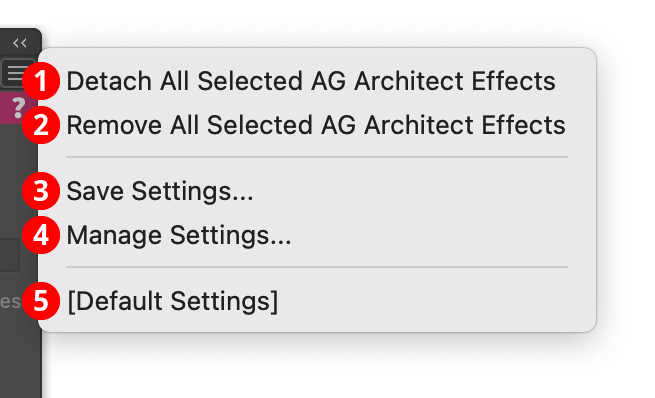
AG Architect Panel Flyout Menu
1. Detach All Selected AG Architect Effects
Changes the extension lines created by all AG Architect live effects in the selection into editable artwork, and removes the effect from the appearance(s). This is similar to using the native menu command Object > Expand Appearance, but is more flexible because it leaves the existing artwork (and other live effects which may be present) intact.
2. Remove All Selected AG Architect Effects
Removes any AG Architect live effects from the selection. (This can be done from the Appearance panel as well, but not if multiple AG Architect effects are present with different parameters. In that case, the Appearance panel will simply display “Mixed Appearances” and the ability to select the live effect and delete it will no longer be available.)
3. Save Settings...
Captures all of the current parameter settings on the panel to a file, which can be instantly recalled later (either in the current file session or a later one). A dialog will appear through which the file name may be specified.
4. Manage Settings...
Brings up a dialog through which existing settings files may be renamed or deleted:

AG Architect Manage Settings Dialog
A. Settings List: Shows all user-saved settings. One or more settings files can be selected for use with the buttons at the bottom of the dialog by clicking on them in the list, with Shift pressed to select contiguously or Command/Ctrl pressed to select discontiguously, as normal.
B. Rename Button: If a single settings file is selected, allows it to be renamed, through a separate dialog. If the Cancel button is used, the original names will be restored.
C. Delete Button: Removes the selected settings file(s). The files are not permanently deleted until the OK button is clicked.
5. Settings Files
User-defined settings will appear below the built-in [Default Settings] menu item. Choosing a settings menu item will load the panel with the settings it had when the file was saved; the AG Architect effects in any selected art will be updated to match.
Illustrator Location:
Illustrator Main Menu > Select > AG Architect Effects
The Stylism plugin adds the menu item AG Architect Effects to the native Select menu. Choosing this menu item will select all unlocked art objects which contain at least one AG Architect live effect.
Illustrator Location:
Illustrator Main Menu > Window > Astute Graphics > AG Architect
The following operation can be recorded and played back as an Action:
1. The menu item Select > AG Architect Effects.
Illustrator Location:
Advanced Toolbar > PathScribe Stack > Extend Path Tool
To use the Extend Path tool, place its cursor near the start or end of an open path (the path does not need to be selected). The cursor will change from a small crosshair to a tail-less arrow, and small lines (red, by default) will appear at the start and end of the path, perpendicular to it, which will dynamically indicate the start and end limits of the path during the drag.
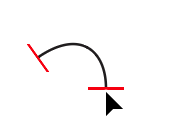
Extend Path Tool Hovering end point
To edit the path, hold the mouse button down. Now a pair of gray lines will appear, indicating how the path would be extended (in both directions), given the current extension mode and parameters. By default, the current length of the path and its change in length will be displayed next to the cursor. The small red square indicates that the Extend Path tool is snapping to an anchor point (here, the endpoint of the original path).
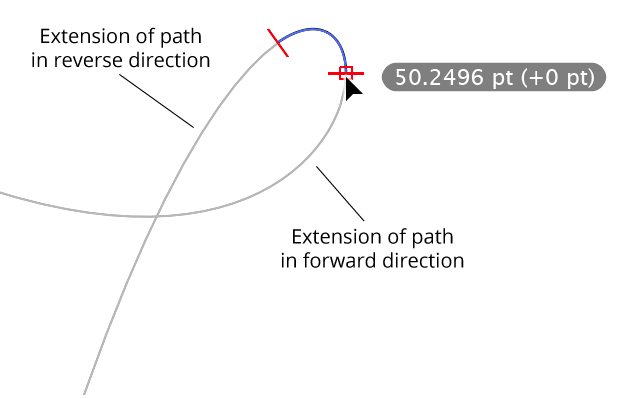
Extend Path Bezier extension complete
Dragging the cursor along the extension preview will move whichever limit line was clicked on, showing the virtual new endpoint of the path. The cursor does not need to be kept directly above the extension preview, as the limit line will snap to the nearest position on the line. Releasing the mouse button finalizes the edit.
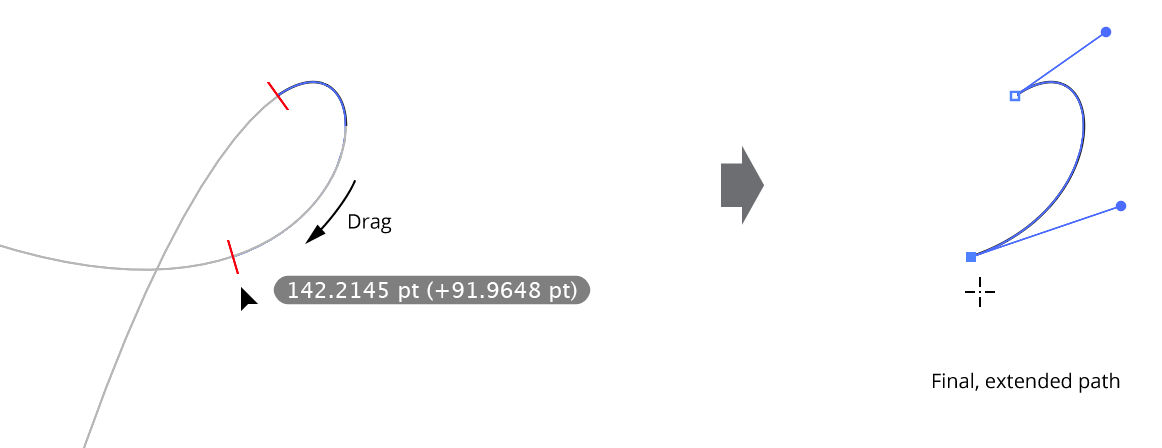
Extend Path Dragging the cursor along the extension preview
During the drag, by default, the cursor will snap to intersections of the extended path to other paths (or to the extended path itself); this will be indicated by a small circle around the limit line:
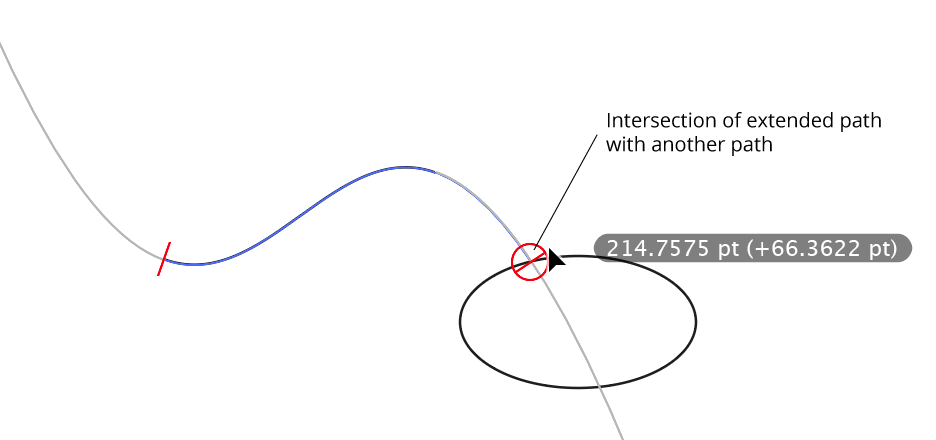
Extend Path Bezier Extension Intersection
Dragging backwards into the existing path will shorten it:

Extend Path Shortening Example
Note: If you drag from the final point of an open path, but then move the cursor so it is over the extension preview that comes from the first point of the path, the path will be extended in the reverse direction but the entire original portion of the path will be removed, as this is equivalent to shortening the path to zero length before starting to re-extend it.
Illustrator Location:
Advanced Toolbar > PathScribe Stack > Extend Path Tool
There are four different modes of path extension: Single Bezier, Constant Radius, Straight, and Spiral.
Single Bezier Extension
This is the default mode for extending a path. In this mode, no additional anchor points are added to the path. Instead, the cubic bezier curve that comprises the path segment being extended is simply expanded. Due to the mathematics of cubic beziers, this may lead to situations where the curve turns in unexpected directions or even reverses direction at a cusp point if the original bezier had only a single handle.
Constant Radius Extension
In this extension mode, the path is continued as a circular arc of constant radius. The radius value itself depends on which radius mode is active: Matched, Scaled, or Fixed. When Matched, the radius value will match the existing radius at the end of the path being adjusted. When Scaled, the radius value will be taken from the existing radius multiplied by a scale value. When Fixed, the radius value will be equal to the fixed value that is specified in the preferences. The circular arc can be extended up to 180°.
Straight Extension
In Straight extension mode, the path is continued as a simple straight line.
Spiral Extension
In Spiral extension mode, the path is continued as a logarithmic spiral with the specified winding constant.

Extend Path spiral extension types
The radius value of the spiral at the start of the path extension depends on the Radius mode, just as with Constant Radius extensions, and the spiral always gets smaller.
Constraining Extensions
When the Constrain Length by Multiples preference is enabled, a path can only be lengthened or shortened so that its total length (or change to its length, depending on the subpreference) is a multiple of the keyboard increment value (when using absolute measurements). So if the keyboard increment is set to 15 pt, the change would constrained to plus or minus 15 pt, 30 pt, 45 pt, etc. When using percentage measurements, changes to the path’s length are constrained to multiples of 5%.
Illustrator Location:
Advanced Toolbar > PathScribe Stack > Extend Path Tool
When the Extend All Selected Open Paths preference is enabled, all selected open paths will be simultaneously lengthened or shortened, in addition to the path under the cursor. Unless randomization is being used, the amount of lengthening or shortening is the same as the dragged path. When randomization has been enabled with the Q key, the values for additional paths are randomly changed by an amount up to the maximum random variation value, which can be changed using the O and P keys while dragging.

Extend multiple paths randomly
Illustrator Location:
Advanced Toolbar > PathScribe Stack > Extend Path Tool
If the Extend Path tool is dragged starting from an empty area of the canvas, it will act as a marquee to select art objects. Shift may be pressed as with the native selection tool to toggle the selection.
Illustrator Location:
Illustrator Main Menu > Effect > AG Utilities > ...
Extend Path is an Astute Graphics live effect for open paths that allows them to be extended (lengthened) or shortened. Extension can be made using four different methods, and randomization options are available.
As with most live effects, Extend Path appears in the main menu, under Effect > AG Utilities. It can also be applied directly from the Appearance panel using the “Add New Effect” button at the bottom of the panel.
Extend Path Parameters Dialog
After applying the live effect using the menu item (or when clicking on the existing effect in the Appearance panel to edit it), the parameters dialog will appear:
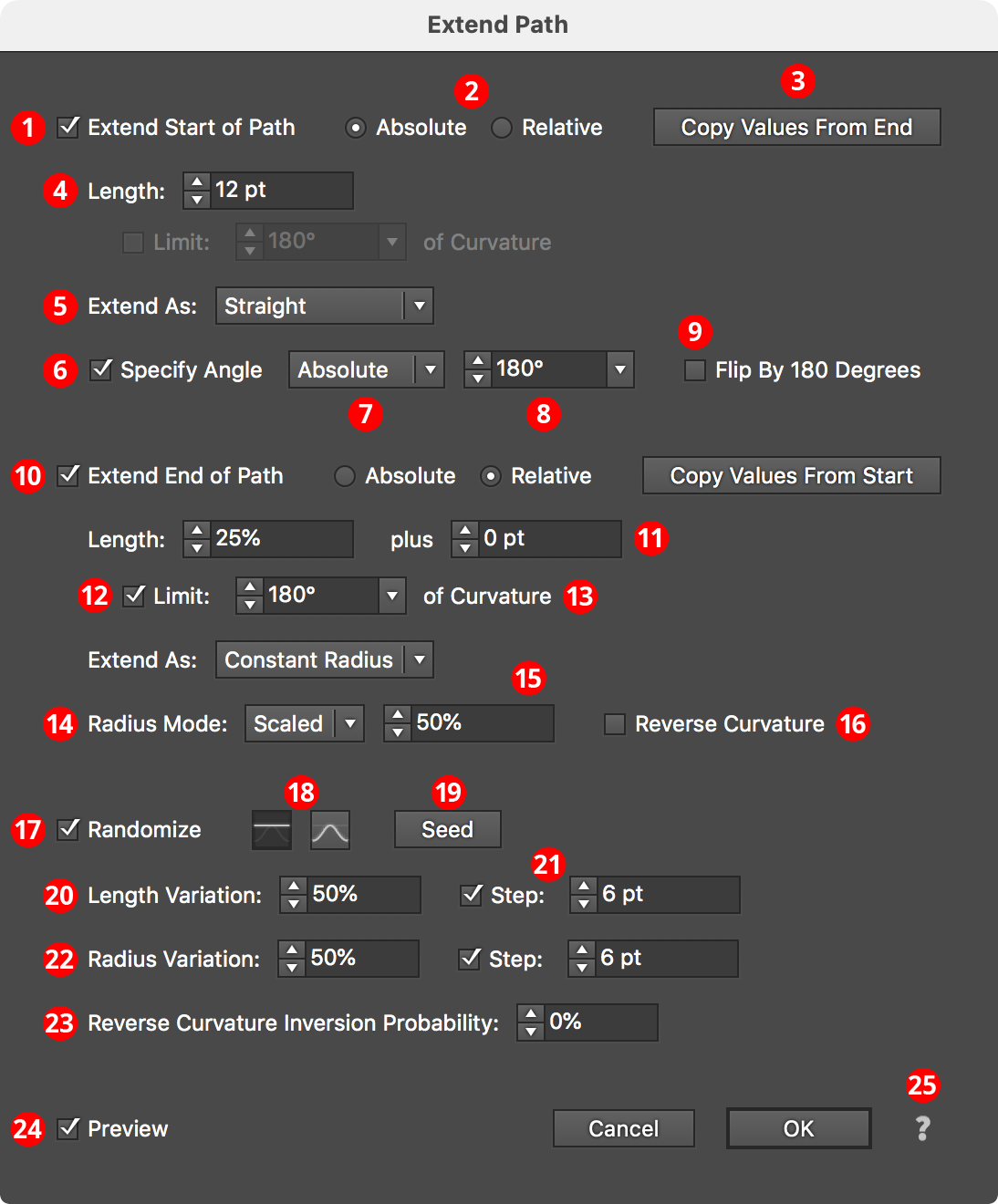
Extend Path Parameters Dialog
1. Extend Start of Path
Each end of the open path can be independently affected. The top section of the dialog pertains to the start of the path.
2. Absolute/Relative
Specifies whether the extension length is an absolutely-specified value (for example, 24 pt) or a value relative to the path length (for example, 50%, which would make the path 1.5 times as long as it was originally).
3. Copy Value button
Allows you to pick up all the parameters from the section of the dialog for the opposite end of the path, in cases where both ends of the path must be extended in the same manner.
4. Length
The amount that the path will be extended or shortened. In Relative mode, the value is interpreted as a percentage of the original path length. Negative values will result in the path being shortened instead of extended.
5. Extend As
The type of extension (ignored when shortening a path).
Bezier Extension
In Bezier extension mode, no additional anchor points are added to the path. Instead, the cubic bezier curve that comprises the path segment being extended is simply expanded. Due to the mathematics of cubic beziers, this may lead to situations where the curve turns in unexpected directions or even reverses direction at a cusp point if the original bezier had only a single handle.
Constant Radius Extension
In Constant Radius extension mode, the path is continued as a circular arc of constant radius. The radius value itself depends on which radius mode is active (see Radius Mode).
Straight Extension
In Straight extension mode (the default), the path is continued as a simple straight line.
Spiral Extension
In Spiral extension mode, the path is continued as a logarithmic spiral with the specified winding constant. Lower winding constants make the spiral’s radii become smaller more quickly.
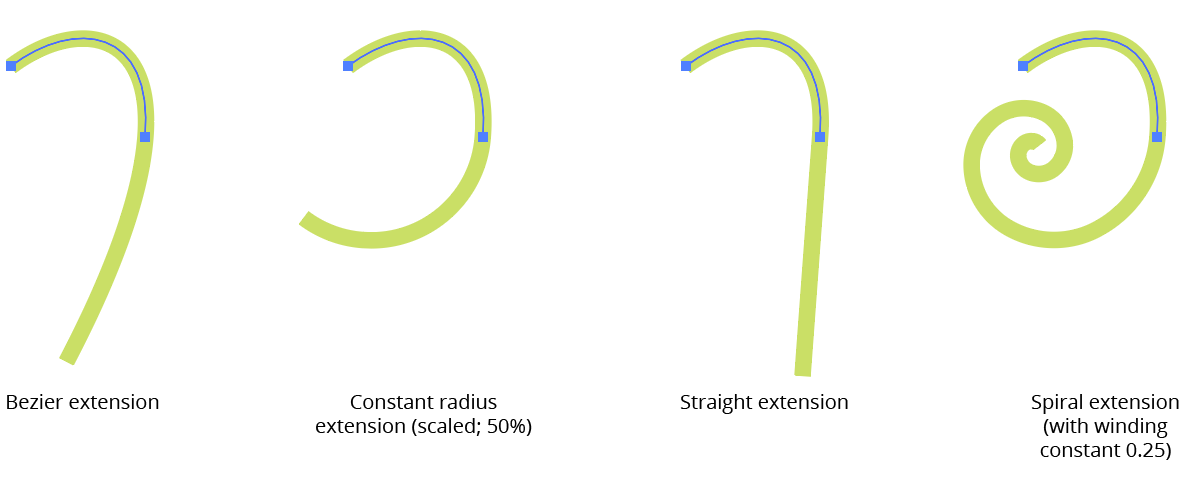
AG Utilities Live Effects - Path Extension Types
6. Specify Angle
Applicable with Straight extensions only; when enabled, the straight extension of the path will not be made at the original angle of the end of the path, but at the specified angle.
7. Specify Angle Mode
When specifying the straight extension angle, you can choose between an absolute angle or an angle that represents the change in angle (“Difference”) between the end of the path and the extension.
8. Specify Angle Value
The final angle, either as an absolute value or as a difference in angles.
9. Flip by 180 Degrees
The final angle is flipped by 180 degrees.
10. Extend End of Path
All controls are identical to the “Start of Path” section, but control the other end of the path.
11. Plus Value
For Relative mode extensions, allows an absolute value to be added to the relative value.
12. Limit Curvature
For Constant Radius and Spiral extensions, limits the length of the extension based on the amount of path bend.
13. Limit Curvature Value
The maximum amount of path bend (in degrees), regardless of length.
14. Radius Mode
For Constant Radius and Spiral extensions, one of the following: Match Radius Mode (the radius value will match the existing radius at the end of the path); Scaled Radius Mode (the radius value will be taken from the existing radius multiplied by the scale value); or Fixed Radius Mode (the radius value will be equal to the specified fixed value).

AG Utilities Live Effects - Extend Path Radius Modes
15. Radius Value
For Scaled and Fixed modes, the scale factor or fixed value.
16. Reverse Curvature
Normally the curvature of the extension is in the same direction as the existing path; Reverse Curvature makes the extension curve in the opposite direction.
17. Randomize
Allows randomization of several parameters, including length, radius, and the probability of reverse curvature. Randomization is most useful when applying the Extend Path effect to a group of many paths, or in an effect stack in which a previous effect breaks a single path into multiple pieces, like Dashify.
18. Distribution Curves
Specifies either a linear distribution in random values (all values in the range are equally likely to be chosen) or a Gaussian distribution (central values in the range are more likely to be chosen).
19. Seed
Each random seed number leads to a different sequence of random values. Clicking the button picks a new seed, thereby changing the look of the artwork. To view or specify the seed number directly, Option/Alt-click the button. This lets you recreate a previously-generated look.
20. Length Variation
Specifies the random variation in the length of the extension. For example, if the length is set to 20 pt, then a variation value of 25% would produce lengths that vary by as much as 20 pt × 25% = 5 pt, that is, between 15 pt and 20 pt; a variation value of 90% would produce lengths between 2 pt and 20 pt.
21. Length Step
Constrains each final extension length (after randomization) to multiples of the specified step value while still remaining in the original range. For example, if the extension length is set to 24 pt with a random variation of 50%, then normally values of 12 to 24 pt would be produced. But enabling Step with a value of 5 pt would result in only values of 15 pt and 20 pt.

AG Utilities Live Effects - Extend Path Randomization
22. Radius Variation
For Constant Radius and Spiral extensions, similar to Length Variation but affects the final radius value.
23. Reverse Curvature Inversion Probability
For Constant Radius and Spiral extensions, specifies the probability that the reverse curvature setting (when enabled) will be inverted to the opposite value.
24. Preview
As with all live effects, when enabled, changing a parameter will immediately update the artwork while the dialog is still open.
25. Help Button
Opens the help documentation in the Astute Manager. If this does not automatically appear, please ensure your Astute Manager is running first.
